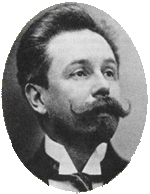Piano Sonata No. 3 (Scriabin)
The 3rd Piano Sonata in F sharp minor op. 23 by the Russian composer and pianist Alexander Scriabin (1872–1915) was written in 1897/98 and has a psychologizing program . Characteristics are in particular the strong thematic bracketing of the four movements and the rich counterpoint .
Emergence
The creation of Alexander Scriabin's 3rd piano sonata in the years 1897/98 fell into a positive phase of the composer's life: In December 1897 he received the Glinka Prize (awarded annually since 1884 by Vladimir Stasov ) for his piano compositions op. 3, 4, 6, 7 and 9, having previously toured Europe successfully as a pianist. In his marriage to the pianist Vera Ivanovna Issakovich in 1897, a daughter was born in the summer of 1898, and in the fall of 1898 Scriabin was offered a professorship at the Moscow Conservatory .
characterization
The sonata with a playing time of about 18 to 20 minutes is in four movements:
- I. Drammatico
- II. Allegretto
- III. Andante
- IV. Presto con fuoco - Maestoso
The sonata was later given a psychologizing program, which was probably written in 1905 by Scriabin's second wife Tatjana de Schloezer, but which was authorized by the composer. In the translation from French it says:
- a) The free, untamed soul plunges into pain and struggle with passion
- b) The soul has found a kind of momentary, deceptive calm […]. But the light rhythm, the fragrant harmonies are only a veil through which the restless, sore soul shines through
- c) The soul drifts on a sea of gentle feelings and melancholy [...]
- d) In the turmoil of the unleashed elements the soul fights as if drunk. The tremendous voice of the God-Man rises from the depths of being, whose song of victory echoes triumphantly! [...]
While the first movement is reminiscent of Franz Liszt in its heroic, triumphant gesture , the second movement, with restless playing figures in the left hand, fulfills the role of a scherzo . The lyrical Andante is characterized by a cantilever opening theme. The finale illustrates the fight and victory of the “soul” according to the above program.
The sentences are to a large extent thematically linked. So the fourth jump of the main theme appears in the first movement in the first theme of the finale. The rhythmic pulse of this theme also appears again in the thematic material of the second, third and fourth movements. Before the transition from the third movement to the fourth movement following attacca , the first theme of the first movement is taken up again. In the coda of the final movement, the theme of the preceding Andante can be heard in the “ Maestoso ” .
Another characteristic of the sonata is its rich contrapuntal work. At the beginning of the implementation of the first movement, the first theme and the secondary theme are heard synchronously over an accompaniment. In the practice of the finale the main theme of the sentence appears first in the inversion and then in increasing stretto counterpoint with itself.
Vsevolod Ivanovich Bujukli played the first performance of the sonata on November 23, 1900 in Moscow with great success. Scriabin himself played it repeatedly until his last concerts.
Individual evidence
- ↑ cit. n. Sigfried Schibli: Alexander Scriabin and his music . Piper, Munich / Zurich 1983. ISBN 3-492-02759-8 , p. 174
literature
- Igor Fjodorowitsch Belsa: Alexander Nikolajewitsch Scriabin . Verlag Neue Musik, Berlin 1986. ISBN 3-7333-0006-8 , p. 96/97
- Christof Rüger (Ed.): Concert Book Piano Music AZ . VEB Deutscher Verlag für Musik, Leipzig, 3rd edition 1988, p. 690/691
- Sigfried Schibli: Alexander Scriabin and his music . Piper, Munich / Zurich 1983. ISBN 3-492-02759-8 , pp. 172-175
Web links
- Scriabin: 3rd Piano Sonata : Sheet Music and Audio Files in the International Music Score Library Project

